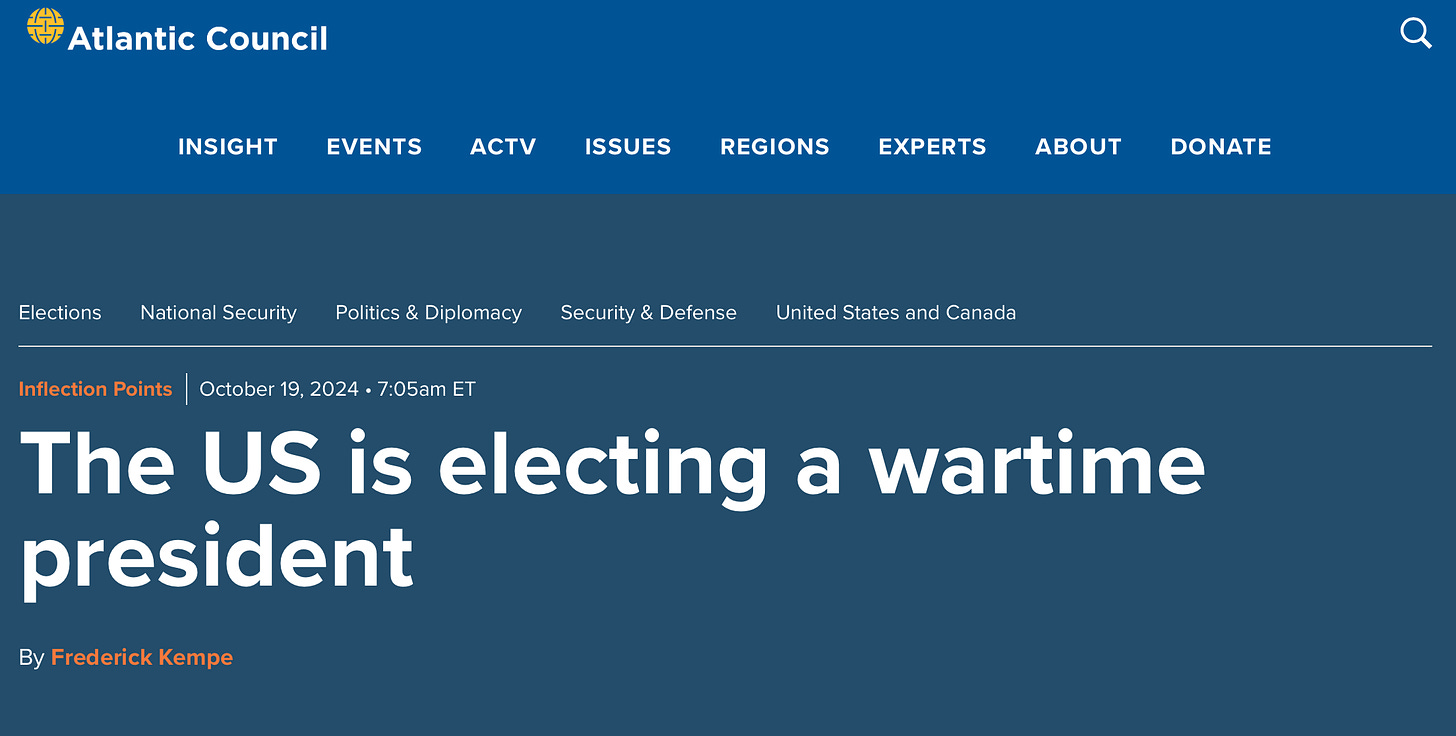This is the way the world ends
This is the way the world ends
This is the way the world ends
Not with a bang but a whimper. – The Hollow Men. T.S. Eliot.
World leaders are meeting in Kazan to launch BRICS’ new trade settlement platform, mBridge, and a raft of novel trade and travel facilities–reducing the dollar’s use as a reserve currency. Simultaneously, Washington must borrow $4.4 trillion next year, just to keep its economy from recession.
The question is: will America fight to defend the dollar’s exorbitant privilege–or will it fold?
The threat
The threat appears more serious the closer we look:
mBridge will save tens of billions of dollars in exchange costs, shorten and simplify international settlements, and shield them from Washington’s prying eyes. (The BRI accounts for 47% of China’s total trade and is growing 6% annually).
The BRICS Grain Exchange and associated pricing agencies for trading commodities like grain, oil, natural gas, and gold, can also be used to settle trade imbalances. (Shanghai has the world’s biggest physical gold exchange).
The BRICS New Development Bank has approved $35 billion for 100 projects.
The China-BRICS Science and Innovation Incubation Park for the New Era is under construction in Xiamen.
The BRICS Network combines the media assets of China, Russia, Iran, India, MENA, FOCAC and Latin America and reaches six-billion BRICS consumers.
The BRICSPay Card, which BRICS sherpas have been using in Kazan for weeks, allows BRICS members to
Circumvent Sanctions: by conducting transactions without relying on weaponized platforms like SWIFT, which have been used to impose sanctions on countries such as Russia.
Maintain trade relations even under external pressure.
Make Transactions in their own Currencies: BRICSPay reduces dependency on the oft-weaponized US dollar, which enhances financial sovereignty and mitigates the impact of unilateral sanctions.
Enhance their Security and Resilience: BRICSPay is a decentralized system that does not rely on a single point of control that could be targeted by sanctions. This structure promotes resilience against external pressures and enhances user security.
Integrate their Domestic Platforms: The system will integrate existing domestic payment networks from each member country, allowing for seamless cross-border transactions, which streamlines payments and makes it harder for external entities to impose restrictions.
Support their own Economic Cooperation and Foster Trade Relations: BRICSPay is part of a broader initiative to enhance economic cooperation among member states. A reliable payment mechanism encourages trade and investment within the bloc, reducing reliance on external markets and sanctions.
Does this mean war?
Driven largely by economic benefits it extracts from the region and by deep-seated domestic challenges, the US has long been the architect of wars in Asia. Even prior to BRICS’ challenge, the Asia-Pacific contained all the elements for conflict. Says Antony Blinken, “Japan, South Korea, Australia and New Zealand attended year's NATO summit on the Indo-Pacific; this has been a deliberate part of our policy, a breaking down of the silos between European alliances, Asian alliances, and even more broadly as we work in countries—and not just countries–other partners from other parts of the world”. Russia’s victory in Ukraine, achieved with a fraction of NATO’s budget and carnage, has shattered the illusion of Western military supremacy. Successive losses in Afghanistan, Ukraine and Palestine leave the West in no condition to fight anyone.
Taiwan?
Earlier this month, the PLA’s navy, air force, rocket, and ground units staged Joint Sword-2024B around Taiwan, as a signal to Washington and Taipei that the rules have changed. Taiwan lies at the heart of Beijing’s strategic and historical interests and China is calling the empire’s bluff. Trapped in its reliance on a crumbling US empire, Taiwan becomes little more than a pawn in the West’s waning influence. Adds Gerry Nolan,
Taiwan’s economy is deeply tied to the mainland, its prized semiconductor exports relying heavily on Chinese markets and maritime access. If a blockade materializes, it won’t just be missiles flying–it will be the lifeline of Taiwan’s economy severed–and all the US weapons in the world can’t change that reality. Washington’s promise of security is an empty shell, just like its wars in Afghanistan, Iraq, and beyond: endless interventions followed by abandonment. The U.S. clings to its outdated first-island-chain strategy but, this time, China holds the lever of maritime control. Drills like soft blockades reveal Washington’s hollow dominance in Asia which, like Britain’s, crumbled after overextending itself.
China’s military rise
Economically, the Polar Route and Eurasian ground transportation provide alternatives to conventional sea routes. EVs are reducing China’s dependence on imported oil and Russia’s natural resources are feeding Chinese industry.
Domestically, Covid allowed 1.4 billion people to rehearse for a nuclear exchange so that, if war comes, communities will make their own contributions to victory, and the nation can fall back on years of stockpiled protein and grains, thanks to Xi’s preparations.
While Western war-fighting capability has been falling, China’s has been rising. The video of a brigade on maneuvers, above, is especially impressive when you consider that the PLA has 82 brigades like it–and the largest, most modern naval fleet and missile armory on earth1. China also controls America’s access to essential minerals like Gallium–without which US technology would collapse–and to critical medicines whose absence would close every American hospital in weeks.
Today’s top domestic Chinese films are "Battle of Changjin Lake" and "War Wolf 2," reflecting the attitude of most Chinese towards war. Last year, civil servants whose offspring held foreign passports were fired and many expect universities to dismiss thousands of pro-American, neoliberal professors this year. China even reassigned senior diplomats to SCS littoral nations, the better to keep the peace.
China’s Coast Guard has become more assertive in preventing Western puppets from occupying more features as the purpose of China’s famous nine-dash line is becomes clear: China will not tolerate hostile forces in its near seas. Adds analyst Beijing Dai,
You think NATO and Russia have consumed a huge amount of ammunition on the Ukrainian battlefield? Trust me, that’s not even a fraction of the PLA stores. Since
2018, says a classmate who works in a military enterprise has rarely attended parties because he always needs to work overtime and weekends told me that inventories of advanced J-20 stealth fighters and J-16 bombers are 300 respectively–far more aircraft than the USAF can field. The PLA upgraded hundreds of old but practical H-6 bombers and the PLAN has commissioned dozens of new ships, including the world's most powerful surface combatants, the Type 055. The rocket force has commissioned huge numbers of hypersonic missiles. China's drone technology leads the world. Most importantly, China has built hundreds of intercontinental missile silos, filled them with nuclear warheads, and even conducted a test in the Pacific last month.
As we saw recently, Iran easily penetrated the West’s best missile defense network with only 180 missiles. In a real war, China could launch 180 advanced missiles an hour for months and wreck every US base west of Pearl Harbor–while the US could not strike targets in China without losing cities like Los Angeles and New York.
The PLA’s exercises are opening acts on a new multipolar stage. As BRICS expands and de-dollarization accelerates, the Global South, unburdened by Western coercion, is writing new rules. The real war isn’t on the battlefield, but in economics, trade routes and currency control–and the West’s defeat looks more certain every day.
After graduation, the supreme commander of China’s military became Assistant to the PLA Chairman of the Joint Chiefs of Staff for three years and met everyone who mattered in the military, mostly because his father was a general at age 17.





